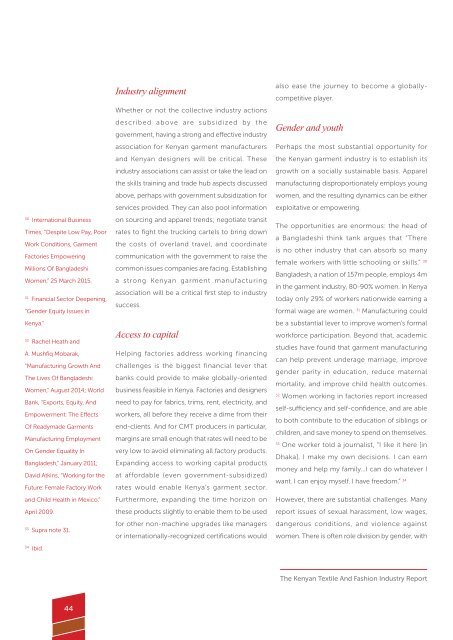Create successful ePaper yourself
Turn your PDF publications into a flip-book with our unique Google optimized e-Paper software.
30<br />
International Business<br />
Times, “Despite Low Pay, Poor<br />
Work Conditions, Garment<br />
Factories Empowering<br />
Millions Of Bangladeshi<br />
Women,” 25 March 2015.<br />
31<br />
Financial Sector Deepening,<br />
“Gender Equity Issues in<br />
Kenya.”<br />
32<br />
Rachel Heath and<br />
A. Mushfiq Mobarak,<br />
“Manufacturing Growth And<br />
The Lives Of Bangladeshi<br />
Women,” August 2014; World<br />
Bank, “Exports, Equity, And<br />
Empowerment: The Effects<br />
Of Readymade Garments<br />
Manufacturing Employment<br />
On Gender Equality In<br />
Bangladesh,” January 2011;<br />
David Atkins, “Working for the<br />
Future: Female Factory Work<br />
and Child Health in Mexico,”<br />
April 2009.<br />
33<br />
Supra note 31.<br />
34<br />
Ibid.<br />
Industry alignment<br />
Whether or not the collective industry actions<br />
described above are subsidized by the<br />
government, having a strong and effective industry<br />
association for Kenyan garment manufacturers<br />
and Kenyan designers will be critical. These<br />
industry associations can assist or take the lead on<br />
the skills training and trade hub aspects discussed<br />
above, perhaps with government subsidization for<br />
services provided. They can also pool information<br />
on sourcing and apparel trends; negotiate transit<br />
rates to fight the trucking cartels to bring down<br />
the costs of overland travel, and coordinate<br />
communication with the government to raise the<br />
common issues companies are facing. Establishing<br />
a strong Kenyan garment manufacturing<br />
association will be a critical first step to industry<br />
success.<br />
Access to capital<br />
Helping factories address working financing<br />
challenges is the biggest financial lever that<br />
banks could provide to make globally-oriented<br />
business feasible in Kenya. Factories and designers<br />
need to pay for fabrics, trims, rent, electricity, and<br />
workers, all before they receive a dime from their<br />
end-clients. And for CMT producers in particular,<br />
margins are small enough that rates will need to be<br />
very low to avoid eliminating all factory products.<br />
Expanding access to working capital products<br />
at affordable (even government-subsidized)<br />
rates would enable Kenya’s garment sector.<br />
Furthermore, expanding the time horizon on<br />
these products slightly to enable them to be used<br />
for other non-machine upgrades like managers<br />
or internationally-recognized certifications would<br />
also ease the journey to become a globallycompetitive<br />
player.<br />
Gender and youth<br />
Perhaps the most substantial opportunity for<br />
the Kenyan garment industry is to establish its<br />
growth on a socially sustainable basis. Apparel<br />
manufacturing disproportionately employs young<br />
women, and the resulting dynamics can be either<br />
exploitative or empowering.<br />
The opportunities are enormous: the head of<br />
a Bangladeshi think tank argues that “There<br />
is no other industry that can absorb so many<br />
female workers with little schooling or skills.” 30<br />
Bangladesh, a nation of 157m people, employs 4m<br />
in the garment industry, 80-90% women. In Kenya<br />
today only 29% of workers nationwide earning a<br />
formal wage are women. 31 Manufacturing could<br />
be a substantial lever to improve women’s formal<br />
workforce participation. Beyond that, academic<br />
studies have found that garment manufacturing<br />
can help prevent underage marriage, improve<br />
gender parity in education, reduce maternal<br />
mortality, and improve child health outcomes.<br />
32<br />
Women working in factories report increased<br />
self-sufficiency and self-confidence, and are able<br />
to both contribute to the education of siblings or<br />
children, and save money to spend on themselves.<br />
33<br />
One worker told a journalist, “I like it here [in<br />
Dhaka]. I make my own decisions. I can earn<br />
money and help my family…I can do whatever I<br />
want. I can enjoy myself. I have freedom.” 34<br />
However, there are substantial challenges. Many<br />
report issues of sexual harassment, low wages,<br />
dangerous conditions, and violence against<br />
women. There is often role division by gender, with<br />
The Kenyan Textile And Fashion Industry Report<br />
44


